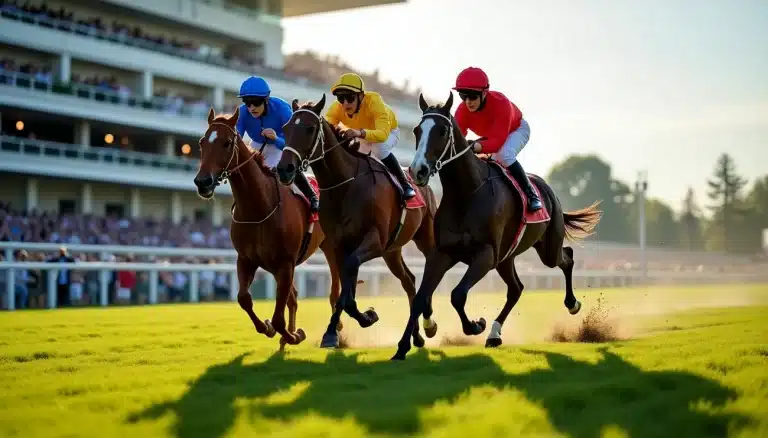When it comes to how to bet on tennis over/under we have got you covered in this article. Tennis ranks among the most popular live betting markets worldwide, and the odds shift after every point played on the court.
Tennis over/under betting has caught fire with bettors everywhere. Picture a match between Djokovic and Alcaraz with a total games line of 22.5 or a women’s match that typically sits at 20.5 or 21.5 games. Your betting success can improve substantially when you understand how to bet on tennis over/under markets.
Random number picking won’t cut it for accurate predictions. You need to understand player matchups, analyze stats, and think about what makes matches run longer or shorter. That’s why we’ve put together this detailed guide to help you become skilled at tennis over/under betting and sharpen your prediction game.
Want to make smarter tennis betting choices? Let’s head over to the essentials of over/under betting strategy.
Understanding Tennis Over/Under Betting Basics
Over/under betting is one of the simplest yet most effective ways to bet on tennis matches. You don’t need to pick a winner. The focus shifts to predicting statistical outcomes – usually the total number of games played.
What exactly is over/under betting in tennis?
Over/under betting (also called totals betting) lets you predict whether a specific statistic in a tennis match will go above or below a number the bookmaker sets. The total number of games in a match is the most popular bet. Here’s what else you can bet on:
- Total sets played
- Player-specific game totals
- First set total games
- Total aces or double faults
This betting style is unique because the match winner doesn’t matter. You just need to predict how the match plays out statistically. To name just one example, a bookmaker might set the line at 22.5 games. Your “over” bet wins with 23 or more games, while an “under” bet succeeds with 22 or fewer games.
How games are counted in tennis matches
Tennis game counting is simple once you understand the match structure. Each set ranges from six to 13 games, with the maximum happening during tiebreaks. Here are some examples:
- A 6-3, 6-4 score adds up to 19 total games (6+3+6+4)
- A 7-6, 6-4 match totals 23 games (7+6+6+4)
- Three-set matches like 6-4, 3-6, 7-5 reach 31 games (6+4+3+6+7+5)
This counting system helps you make better over/under predictions.
Common over/under lines explained
Player matchups, tournament format, and surface influence how bookmakers set their lines. Men’s matches between equal opponents usually have thresholds around 23.5 or 24.5 games in best-of-three matches. Men’s tennis sees more service holds, which explains these numbers.
Women’s matches have lower lines at 20.5 or 21.5 games because service breaks happen more often. Both sides typically start with 17/20 odds (or -110 in American odds).
Bookmakers also provide different thresholds with varying odds. A match with 17/20 odds on either side for 23.5 games might offer 33/100 for over 20.5 games and 2/1 for under 20.5 games.
Player styles matter a lot in over/under betting. Aggressive servers with quick styles create shorter matches with fewer games. Defensive players who rely on ground strokes lead to longer rallies and more games overall.
Analyzing Player Matchups for Better Predictions
Tennis players’ matchups are the foundations of successful over/under betting. The dynamics between opponents often reveal patterns that odds makers might miss.
Evaluating playing styles and their effect on game length
Playing styles shape match duration and total game counts. Research points to three distinct styles that affect match length:
- Attacking players (who hit hard and approach the net) average just 4.8 seconds per rally with only 21% of match time spent in actual play
- Whole court players (comfortable at baseline and net) average 8.2 seconds per rally with 28.6% active playing time
- Baseline players (who stay back, hitting groundstrokes) average 15.7 seconds per rally with 38.5% active playing time
Baseline players create longer matches with more games, making them good picks for “over” bets. Matches between aggressive servers wrap up faster, which makes them better suited for “under” bets.
Head-to-head history analysis
The mental aspect of tennis makes head-to-head records vital for predicting outcomes, Tennis tipsters often look at this avenue when compiling their tips. Players often develop psychological edges when they beat an opponent repeatedly. Tsitsipas’s comment after losing his first five matches against Auger-Aliassime shows this clearly: “It’s upsetting that he’s better than me… I might never beat him”.
Despite that, win-loss records shouldn’t be your only guide. You should look at:
- Recency (matches over two years old lose approximately 10% relevance)
- Surface compatibility (a 5-2 head-to-head advantage might reverse completely on different surfaces)
- Tournament significance (Grand Slam performances carry more weight than smaller events)
Serve and return statistics that matter
Serving statistics best predict match length. The first serve win percentage predicts match winners about 80% of the time. The second serve win percentage follows close behind at 74%.
Return game analysis adds another layer of insight. The most telling metrics include first and second serve return points won, break points converted, and return games won. Game totals depend heavily on how one player’s serve matches up against their opponent’s return skills.
Smart tennis over/under bets need a good look at both players’ serve percentages and their performance against specific returning styles.
Key Factors That Influence Match Length
Tennis over/under bets can change based on several factors players can’t control. You’ll get better at predicting match length by learning about these elements.
Court surface considerations
The court surface plays a huge role in how matches play out. Clay courts slow down the game a lot – rallies at the French Open last 7.7 seconds compared to just 4.3 seconds on Wimbledon’s grass courts. Clay matches have 20-30% of total match time in active play, while faster surfaces only see 10-15%.
Betting on slower surfaces like clay? Go for the “over” since these courts lead to longer rallies and favor baseline play. Fast surfaces like grass or hard courts make the ball skid quickly and bounce lower, so “under” bets usually work better.
Tournament format and best-of-three vs. best-of-five
The match format directly shapes game totals. Best-of-three matches usually run 90 minutes to two hours. Best-of-five matches can stretch from two to five hours. Men’s singles Grand Slam matches take about three and a half hours on average.
The French Open, played on clay, gives great chances for over bets because matches often go the full distance. Even top players tend to drop sets unexpectedly in best-of-five formats.
Weather conditions and their effect
The weather can really change how matches unfold. Hot days increase ball pressure, making play faster. Players might think humidity slows the ball, but it just makes them more tired.
A light rain makes tennis balls about 1% heavier, which slows play and makes spin shots harder. Wind messes with ball trajectory and forces players to adjust their positioning, making rallies longer.
Player fitness and fatigue levels
Players with great stamina tend to push matches to their limits. Fatigue builds up quickly in tournaments where players compete multiple times with less than 48 hours of rest.
Studies show that players still feel tired even 24 hours after a match. This leftover fatigue matters a lot when betting on players in later tournament rounds, and it’s why “under” bets often work well – tired players try to end points faster.
Step-by-Step Tennis Betting Strategy for Over/Under
A well-laid-out strategy and full picture are essential to succeed in tennis over/under betting. Let me share a tactical guide that will help you make more profitable tennis betting decisions.
Pre-match research checklist
Your success in over/under betting starts with complete research. Before you place your bet, think about:
- Playing styles: Players with aggressive serves create shorter matches. Players who prefer baseline rallies make games last longer
- Surface compatibility: Games on clay courts last 20-30% longer than those on faster surfaces
- Recent form: Players returning from injury tend to play shorter matches
- Head-to-head history: Some matchups stay tight, whatever the rankings
- Weather forecast: Wind and humidity can change play styles and match duration by a lot
Service statistics are a great way to get match length predictions, so look at them carefully.
Setting your line before checking the bookmaker’s odds
We calculated our expected game total first, before looking at bookmakers’ lines. This helps avoid anchoring bias and spots value opportunities. Three-set matches between equal men’s players usually hit around 23.5-24.5 games. Women’s matches average 20.5-21.5 games.
You’ve found potential value when your calculated line differs greatly from the bookmaker’s.
Bankroll management for over/under bets
Pro bettors suggest using 1-3% of your total bankroll per bet. For example, a £1,000 bankroll means keeping single bets between £10-£30. Another approach is to split your bankroll into 50-100 units for steady betting.
Don’t increase your stakes too much during hot streaks – steady betting leads to long-term profits. Cut back your bets when losing to protect your money.
When to place your bet: Timing considerations
Tennis matches are a great way to get in-play betting chances as odds change with momentum swings. When one player dominates early, over lines become more attractive because bookmakers adjust expectations down.
Matches going to final sets usually favor “over” bets. One-sided matches work better for “under” bettors.
Sharp odds increases on either side often show pro money entering the market based on insider info or statistical edges.
How to Bet on Tennis Over/Under – My Conclusion
Tennis over/under betting lets you wager beyond just picking winners. Smart betting decisions come from carefully analyzing player matchups, court conditions, and match formats carefully.
Your success in over/under betting depends on solid research and understanding several key elements. Court surfaces substantially affect how long matches last. Player styles and head-to-head records give a clear picture of possible game totals. Weather conditions and tournament formats add complexity that savvy bettors need to think over.
Disciplined bankroll management matters more than emotional betting choices. Test your strategy with small stakes first. You can raise your bets gradually as your confidence grows. Consistent analysis, patient execution, and learning from results drive your success.
These tools and strategies will help you make smarter tennis over/under bets. Focus on statistics instead of getting wrapped up in picking winners. A long-term viewpoint helps you place better wagers consistently.
How to Bet on Tennis Over/Under FAQs
Q1. What is over/under betting in tennis? Over/under betting in tennis involves predicting whether the total number of games played in a match will be higher or lower than a line set by the bookmaker. For example, if the line is 22.5 games, an “over” bet wins if 23 or more games are played, while an “under” bet wins with 22 or fewer games.
Q2. How do playing styles affect tennis over/under bets? Playing styles significantly impact match duration and game totals. Aggressive players tend to produce shorter matches, favoring “under” bets, while baseline players typically lead to longer matches with more games, making them favorable for “over” bets.
Q3. What factors should I consider when placing tennis over/under bets? Key factors to consider include player matchups, court surface, tournament format, weather conditions, and player fitness levels. Clay courts, for instance, tend to produce longer matches, while faster surfaces like grass often result in shorter matches.
Q4. How important are serving statistics in tennis over/under betting? Serving statistics are crucial for predicting match length and making informed over/under bets. First serve win percentage alone correctly predicts match winners about 80% of the time, while second serve win percentage predicts winners roughly 74% of the time.
Q5. What’s a good strategy for tennis over/under betting? A solid strategy involves thorough pre-match research, setting your line before checking the bookmaker’s odds, practicing disciplined bankroll management, and considering the timing of your bets. It’s also important to analyze player matchups, recent form, and head-to-head history before placing your wager.



